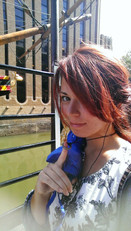The Eyes on the Waves
- Renée Whitehouse

- Feb 25, 2020
- 5 min read
In the early days of maritime travel large creatures sailed over the ocean waves, their unblinking eyes ever vigilant to dangers just beyond the horizon.
“At the bows . . . was the ship’s figurehead,
either a ramping red lion or a plain white bust,
or a shield, or some allegorical figure suggested by
the name of the ship . . . [the sailors] took
great pride in keeping it in good repair.”
~ JOHN MASEFIELD, “SEA LIFE IN NELSON’S TIME”
Most of us are well aware of the existence of figureheads. The large carvings on the bows of ships, but they could also be paintings and even real heads, before being substituted for the symbolic ones (Kemp, 1976). Common examples are mermaids or other busty women, powerful-looking men, angels, horses, dragons, and the list goes on. They have to been said to embody the spirit of the ship, to provide protection and help with other specific goals depending on the form the figurehead would take. Since their inception up to today, each one had and has deep meaning, but not all of them have been full carvings. Some of the earliest sea traveling peoples; Egyptians, Indians, Phoenicians, Greeks, early Romans, and Chinese, built their ships and painted large eyes on the bow (front) of the vessel (Encyclopædia Britannica inc., 1999).
From the information I could find, the animal sacrifices either tied to the beakhead or the mast, or set up on a pike would have come first (Jeans, 2007; 308). These were supposedly two-fold in their purpose (Jeans, 2007; 308). Firstly, sacrifices to the Gods were common occurrence in the ancient world. No one wanted to piss off the beings that control your fate. One only needs to read the Odyssey (the one with the happy ending), or Greek myths in general, to see how that works out. Secondly, the figurehead would be presented as a manifestation of the spirit of the vessel while keeping their eyes out to find the safe passage. It was common for general locations to mark themselves with their own specific figures, reminding me a lot of flags for the 'country'. As even as early as 1000 BC ships would further specify their ships by painting or carving onto the stern of the vessel.
According to Peter Kemp,"The ancient Egyptians mounted figures of holy birds on the prows, whilst the Phoenicians used the heads of horses to symbolise both vision and swiftness. Greek ships had a boar’s head for both its quick sight and ferocious reaction and Roman ships often carried a carving of a centurion to indicate their prime fighting quality". The last wouldn't have been a physical sacrifice, I hope. "William the Conqueror’s ship pictured in the Bayeux Tapestry had a lion’s head carved on the top of her stem; by the 13th century one of the favourite figureheads was a swan, possibly in the hope that the ship would then possess the same mobility and stability on the water as the bird. Some Danish ships portrayed a dolphin or bull, while a serpent was also popular in Northern Europe" (Kemp, 1976).The swan, as an elegant bird could also be seen on the Roman ship fronts (shown below).
[photos above are either taken by me or the illustrationations taken off of Google Images. The first 5 -from left to right- were from Oslo, Norway in 2015. Second two are 2 views of the Golden Hind deer head in London from 2014. Next 6 are from my visit to the Greenwich Maritime Museum in London from 2014, along with the last selfie.]

In the more ancient of those listed above, the Egyptian, Phoenicians, and Greeks, the latter two built Triremes, which became the most common warship style. While they fell out of fashion in the Peloponnesian War
with the rise of the quadriremes and quinqueremes after the Persian Wars and the creation of the Athenian maritime empire (Morrison, 1968), they seem to be synonymous with the painted eyes. The Athenians would change up the use by carving the prow as a battering ram, therefore, instead of being only symbolic the fear from the 'creature' would be actionable.
What looks to be the case (pun completely intended) is that no matter what style of ship the eyes were of use, merchant ships for protection, warships for fear, both to honor the Gods. Phoenician ships included eyes that were intended to help the ship “see” and to frighten enemies, as well as horses’ heads to honor their god of the sea, Yamm. Egyptian ships, the earliest of which were made of reeds dating around 6000 BCE changed to the styles with sails which used timber harvested after Hatshepsut establishing trade routes with Lebanon dating back to approx. 1470 BC (or 3450 BCE). The funeral barges and the later trading vessels had a falcon or falcon eyes, the symbol of Horus and thus the pharaoh who was Horus' living embodiment. Under Ramesses III (reigned from 1187-53 BCE) continued the expansion of Egyptian trade routes by having vessels sail across the Indian Ocean. All of these trade routes would grow over time and eventually become the long Maritime Silk Route, ranging from stops in Rome to China and even Southern Japan.

Trade ships in India and the Junk ships in China (2800 BCE) are also said and shown to have eyes painted on the bow area. The Chinese junk ships were used earliest for the exploration, trade, and warfare around Southeastern Asia and they also likely trading with India by 7th CE based on Muslim writings in the Euphrates valley (Waldman, 2004). The small jumps in between countries, which eventually created a large leap may have been fully connected by between 1500-1000 BCE*.
*There is much more work to be done in this area of research and it's full connections are not known.
We know that with trade comes cultural change. Did the stories exchanged make a difference of arts and ship figurehead ideas? I really don't know, it's my favorite idea for a research project.
Lastly, they would paint eyes or faces on planes as well, especially popular in the earlier days of flight, and going through WW2.
Even with he transfer to ship in the air, [first two pictures are from WWI examples, the last 5 are examples from WW2] the eyes and figureheads are still represented.
If we don't do it anymore, what could we lose? Are we still superstitious? Maybe it's just fun...
(Just extra eye in Chinese Junk info... if there is more info about their meaning I'm sorry, but I couldn't find archaeological interpretations. If you know any send the info my way. :D )
Citations and For More Information:
Costa, G. Figureheads: carvings on ships from ancient times to twentieth century Lymington: Nautical, 1981
Encyclopedia Britannica. (1999). Figurehead | sculpture. [online] Available at: https://www.britannica.com/art/figurehead.
Jeans, Peter D. Seafaring lore and legend. McGraw Hill Professional, 2007. [link to buy from amazon] or
<file:///Users/orpheus/Downloads/Seafaring%20lore%20%20legend%20%20a%20miscellany%20of%20maritime%20myth,%20superstition,%20fable,%20and%20fact%20by%20Peter%20D%20Jeans%20(z-lib.org).pdf>
Joshua J. Mark. “Phoenicia,” Ancient History Encyclopedia. Last modified September 02, 2009. http://www.ancient.eu/phoenicia/.
Kemp, Peter, and Ian Dear, eds. The Oxford companion to ships and the sea. Vol. 627. London: Oxford University Press, 1976.
Morrison, John S., David Morrison, and R. T. Williams. Greek Oared Ships 900-322 BC. Cambridge: Cambridge University Press, 1968.
Waldman, Carl, and Alan Wexler. Encyclopedia of Exploration, Vol. 1-2. New York: Facts On File, 2004.
Weaver, Stewart A. Exploration: A Very Short Introduction. New York: Oxford University Press, 2015.



















































Comments